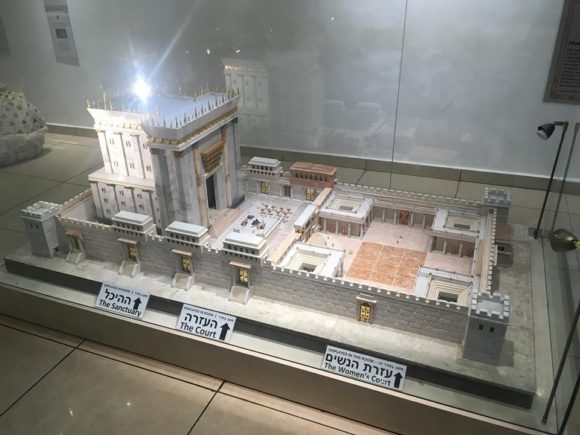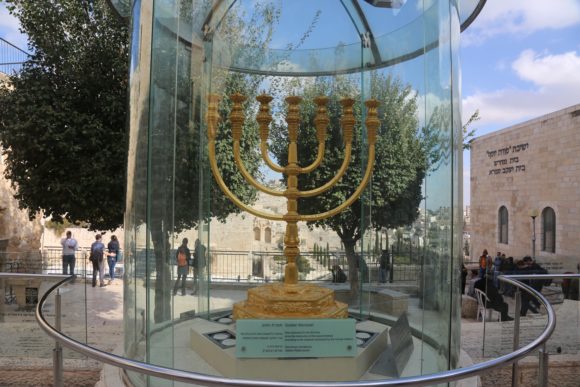After failing to blow up the Dome of the Rock in 1984, Yehuda Etzion of the “Jewish Underground” messianic terrorist group realized his mistake while in prison.
Their plan to destroy the “abomination,” was appropriate; the only problem was that they acted ahead of their time, Etzion argued.
“The generation was not ready,” Etzion wrote in a letter while incarcerated.
Once out of prison Etzion established the Chai Vekayam (Alive and Existing) movement, which believes in shaping public opinion as a prerequisite for building a Third Temple in the religious complex in Jerusalem’s Old City where Al Aqsa Mosque and the Dome of the Rock are located, otherwise known as the Noble Sanctuary. In addition to housing Islam’s third most holiest site in the world, the compound is also one of Judaism’s most sacred sites and the desired location for the Third Temple.
In his prison letter he explained, destroying the Dome of the Rock could be part of the plan,
“We must build a new force that grows very slowly, moving its educational and social activity into a new leadership. Of course I cannot predict whether the Dome of the Rock will be removed from the Mount while the new body is developing or after it actually leads the people, but the clear fact is that the Mount will be purified [from Islamic shrines] with certainty…”
Three decades later, “the process of ‘preparing the hearts’ that precedes the practical stage of removing the Dome of the Rock is now underway in full force,” noted Israeli NGO Ir Amim in their 2013 report, “Dangerous Liaison.”
Since then dozens of organizations have formed with the goal of promoting “temple awareness”- raising awareness about the Third Temple’s importance and its construction. In 2013 Ir Amim noted 19 registered associations that call for changing the status quo at the Noble Sanctuary.
Since 1967, Israel has controlled the entrance to the Noble Sanctuary and the compound is administered by Islamic Waqf seated in Jordan. Non-Muslims can enter the site as tourists, but cannot pray there.
Today, discussion about changing the status quo on the Al Aqsa compound and building the Temple is part of Israeli mainstream discourse.
2017 was a record breaking year in many aspects including an increase of 75 per cent in Jewish visits to the compound. In 2017 around 25,600 Jews visited the compound compared to around 14,600 in 2016.
Last October, around 500 Jewish activists practiced their ritual next to the Southern Wall, closer to the compound than ever before.

The Temple Institute’s model of the Third Temple. (Photo: Mersiha Gadzo)

The Temple Institute’s recreated Golden Menorah displayed outside is ready to be used in the Third Temple once it’s built. Temple Institute leadership claims that by placing the menorah in full view of anyone heading to the Western Wall from the Jewish quarter, helps promote the idea of rebuilding the Third Temple.
(Photo: Mersiha Gadzo)
“The struggle is about sovereignty”
Many Temple activists have openly admitted that praying at the compound is just the first step in achieving their greater goal of building the Third Temple inside the Noble Sanctuary. It’s why Palestinians remain concerned about increased Jewish visits to the compound.

Yehuda Etzion inside the Nobel Sanctuary in Jerusalem, 2015 (Photo: Honenu/YNET News)
Elishama Sandman, founder of Yeraeh, which publishes weekly statistics on the number of Jews visiting the Noble Sanctuary. Using the Jewish term for the compound, the Temple Mount, she stated:
“Our aspiration is to build a Temple on the Temple Mount. In order to get to a Temple, there is a path that must be followed, and along this path there are various milestones that are effectively our more immediate goals: Allowing open and free prayer on the Mount, extending entry hours for Jews as well as broad awareness among the people and so forth.”
Former Likud member Moshe Feiglin revealed the real intention behind the call to Jewish prayer at the compound:
“Let’s be truthful. The struggle here in not about prayer,” Feiglin admitted. “Arabs don’t mind that Jews pray to God. Why should they care? We all believe in God. The struggle is about sovereignty. That’s the true story here. The story is about one thing only: sovereignty.”
Last summer, right-wing rabbis called for increased visits “to strengthen our hold on this holy place.”
Motti Inbari, professor of Religious Studies at the University of North Carolina at Pembroke agrees that the Jewish activists’ “act of going up the Temple Mount is an act of showing ownership” over the site.
“Building the Third Temple is viewed as something futuristic, not something that’s going to happen soon,” Inbari told Mondoweiss.
“But Jewish presence on the Temple Mount and Jews coming to pray is viewed as a more realistic goal that they can achieve to symbolize ownership,” he said.
Likud Knesset member Yehuda Glick has played a key role for more than a decade in promoting Jewish visits to the compound and calling for their right to prayer.
According to Glick, when he first ascended the compound in 1990, Jewish visitors were let in only one at a time and there were only three rabbis who supported their cause since leading rabbis have repeatedly ruled that it is forbidden for Jews to enter any part of the compound due to the site’s sacredness.
Now, groups of 50 and more typically visit (sometimes over 100) and according to Glick, there are around 300 rabbis who support their call.
“They have successfully changed the halachic [Jewish law] position concerning ascent to the Mount among the Council of Yesha Rabbis and even to expose rifts within the Haredi public, for which activity promoting the rebuilding of the Temple as a practical program was once entirely insupportable,” Ir Amim noted.

Palestinian Muslims arrive at Al Aqsa mosque for Friday prayer. January 2017. (Photo: Mersiha Gadzo)

A view of the Dome of the Rock taken from outside of the Temple Institute. (Photo: Merisha Gadzo)
“A particularly alarming trend”
One of the leading Temple movement organizations is the Temple Institute, which has had a blueprint ready for the temple’s construction since 2011. In 2014 they crowdfunded over $100,000 on Indiegogo to prepare architectural plans for their Third Temple.
“This is the generation. The children are ready,” reads the tagline in one of their videos which often show the youth leading their parents and the elderly away from distractions and towards the Third Temple.
Their ultimate goal is no conspiracy theory.
The dozens of ritual objects that are displayed in Plexiglass cases at the institute aren’t merely replicas. They have been specifically made to be used in the Third Temple once it’s rebuilt.
“The Temple Institute’s ultimate goal is to see Israel rebuild the Holy Temple on Mount Moriah [where the Al Aqsa compound is located] in Jerusalem, in accord with the Biblical commandments,” reads their statement on their website.
At the institute, paintings are displayed on walls depicting visitors arriving by light-rail train and cable car. They gaze at the gigantic Third Temple, clearly located in today’s Al Aqsa Compound. In all of their illustrations, there is no Dome of the Rock or Al Aqsa mosque in sight.
With the Midrasha, the Temple Institute’s educational arm, their “growing infiltration” of the Israeli education system is a “particularly alarming trend,” according to Ir Amim.
“By presenting itself primarily as an educational body, without emphasizing its ultimate goal of rebuilding the Temple, the Institute has been successful in garnering support,” Ir Amin wrote, “Because there is no other organization representing an alternative viewpoint, students receive a blatantly biased perspective. In this way, both secular and religious students under the Education Ministry are exposed to a one-dimensional approach to the subject.”
From 2008 to 2011 the Temple Institute and Midrasha received an average of $110,000 (412,000 NIS) in state funding. In 2012, the most recent year that statistics are available, Midrasha received $230,000 (819,000 NIS) from the Ministry of Education.
The Temple movements’ influence reached the Knesset as well. From May 2013 until October 2014, the Knesset Interior Committee held 14 discussions concerning the issue of Jewish entrance and prayer to the compound, compared to four discussions in the entire preceding decade.
Glick also formed a lobby that successfully convinced Israeli decision makers in 2015 to outlaw the Mourabitoun movements, guardians of Al Aqsa mosque.
“Religious groups that joined the Likud Party ranks have raised the curtain on the issue, making it mainstream,” Glick said in an interview. “[…] I was present at all these junctures and used all the tools to give the idea a serious push.”
According to a poll from 2013, about a third of Israelis support building the Third Temple in the Al Aqsa compound.

Omar Kiswani, director of the Al Aqsa mosque compound. (Photo: Mersiha Gadzo)
Recently, the battle over Al Aqsa’s sovereignty has shifted to legal grounds. Last October the Supreme Court ruled that soccer games are forbidden on the compound because it desecrates the site’s holiness. Palestinian youth often play soccer in Al Aqsa’s courtyard since there are few places where they can freely do so in their neighborhoods in occupied East Jerusalem.
The Waqf has refused to respond to summons sent by Israeli courts to hear claims filed against it, since they don’t recognize Israeli law over Al Aqsa. They maintain that Israel has no authority to interfere in Al Aqsa’s affairs.
According to Omar Kiswani, director of the Al Aqsa compound, since the prayer protests led by Palestinians last July, Israeli authorities have maintained their ban on tools, electric cables and renovation materials from entering the compound, consequently halting much-needed renovation for the mosque. Any minor maintenance now requires approval from the Israeli police. As of January 2017 renovation plans have still been frozen.
“Even cleaning. We need approval from Israeli police to clean,” Kiswani said. “It’s because they want to change the status of Al Aqsa. They want to have more control over the mosque.
“[The Israelis] will take quicker steps in the future [to assert sovereignty.] Now, the battle is with the Waqf inside the mosque. The Israeli government has been trying to find a way to impose their policies without provoking Palestinians.
“For the public outside it appears quiet, but this is an illusion. It’s not peace and quiet. We are afraid that if it continues like this the situation will explode.” Kiswani said.
Source Article from http://mondoweiss.net/2018/02/preparing-movement-building/
 RSS Feed
RSS Feed















 February 17th, 2018
February 17th, 2018  Awake Goy
Awake Goy  Posted in
Posted in  Tags:
Tags: 













